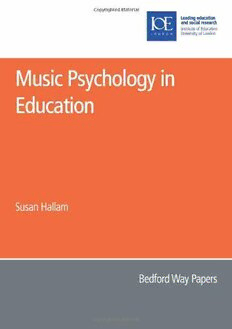
Music Psychology in Education PDF
Preview Music Psychology in Education
Music Psychology in Education TheBedfordWayPapersSeries 6 MenasWorkersinServicesforYoungChildren:Issuesofamixedgenderworkforce EditedbyCharlieOwen,ClaireCameronandPeterMoss 7 ConvergenceandDivergenceinEuropeanEducationandTrainingSystems AndyGreen,AlisonWolfandTomLeney 8 FEandLifelongLearning:Realigningthesectorforthetwenty-firstcentury EditedbyAndyGreenandNormanLucas 9 ValuesandEducationalResearch EditedbyDavidScott 10 TheCultureofChange:CasestudiesofimprovingschoolsinSingaporeandLondon Peter Mortimore, Saravanan Gopinathan, Elizabeth Leo, Kate Myers, Leslie Sharpe,LoiseStollandJoMortimore 11 EducationandEmployment:TheDfEEanditsplaceinhistory EditedbyRichardAldrich,DavidCrookandDavidWatson 12 TheMathsWeNeedNow:Demands,deficitsandremedies EditedbyClareTicklyandAlisonWolf 13 WhyLearnMaths? EditedbySteveBramallandJohnWhite 14 HistoryofEducationfortheTwenty-FirstCentury EditedbyDavidCrooksandRichardAldrich 15 TheChildrenofLondon:Attendanceandwelfareatschool1870–1990 SusanWilliams,PatrickIrvinandCarolineMorse 16 DevelopingInclusiveSchooling:Perspectives,policiesandpractice EditedbyCarolCampbell 17 SchoolTextbookResearch:Thecaseofgeography1800–2000 NormanGraves 18 ChangingBritain,ChangingLives:Threegenerationsattheturnofthecentury EditedbyElsaFerri,JohnBynnerandMichaelWadsworth 19 TeacherPayandPerformance PeterDolton,SteveMcIntoshandArnaudChevalier 20 ChildhoodinGenerationalPerspective EditedbyBerryMayallandHelaZeiher 21 Homework:Theevidence SusanHallam 22 TeachinginFurtherEducation:Newperspectivesforachangingcontext NormanLucas 23 Legalised Leadership: Law-based educational reform in England and what it does to schoolleadershipandheadteachers DanGibton 24 TheorisingQualityinHigherEducation LouiseMorley Music Psychology in Education Susan Hallam Bedford Way Papers Firstpublished in2006bytheInstituteof Education, University ofLondon, 20Bedford Way,London WC1H 0AL www.ioe.ac.uk/publications Over 100years ofexcellence in education #Instituteof Education, Universityof London 2006 SusanHallam assertsthemoral right tobe identifiedas theauthorof thiswork. Allrights reserved.Nopart ofthis publication maybereproduced,storedina retrievalsystem, ortransmittedinanyform orbyanymeans, electronic, mechanical,photocopying,recordingorotherwise,withoutthepriorpermissionof thecopyright owner. British Library CataloguinginPublication Data: Acatalogue recordfor thispublication isavailable from theBritish Library ISBN 0854737162 TextdesignbyJoan Rose Cover designbyAndrew Chapman PrintedbyAldenGroup Ltd, Oxford Contents Preface vii 1 Introduction 1 2 Music, the brain and learning 11 3 Early development 29 4 Musical ability 44 5 Listening, appraising and responding to music 57 6 Composing and improvising 70 7 Learning to play an instrument and develop vocal skills 91 8 Learning through practice 118 9 Motivation and musical identity 142 10 Assessment 155 11 Teachers and teaching 165 12 The impact of music through life 179 References 194 Index 277 Preface Thepsychologicalstudyof musichasalonghistory,whichparallels the development of psychology as a discipline. The first simple test of musical ability was developed in 1883 by Stumpf. This marked the beginning of a long tradition of psychometric testing in music. Other early work focused on learning and memory; the perception andcognitionofmusic;andpracticalissues,forinstance,theimpact of background music on studying. The field is now well established, withresearchbeingundertakeninrelationtoeveryaspectofhuman musical behaviour. Although much of the research is of direct concern to music educators, it has not been presented in an easily accessible, single volume. This book attempts to address that issue, reviewing research that has relevance to education and making explicit its implications. 1 Introduction The nature of musical sound Music is a human construct. While sound may exist as an objective reality, for that sound to be defined as music requires human beings to acknowledge it as such. As Radocy and Boyle put it: Ifsoundsarecreatedorcombinedbyahumanbeing,recognisedas music by some group of people and serve some function which musichascometoserveformankind,thenthosesoundsaremusic. (1988:19) What is acknowledged as ‘music’ varies between cultures, groups and individuals. For instance, the Igbo of Nigeria have no specific term for music; their term nkwa denotes ‘singing, playing instru- ments and dancing’ (Gourlay, 1984). The Oxford Dictionary defines music as: The art of combining sounds of voice(s) or instrument(s) to achieve beauty of form and expression of emotion. To define music in these terms depends on subjective judgements of what constitutes beauty of form and expression of emotion. This mayvaryfromindividualtoindividual.Indeed,somemayarguethat what constitutes ‘music’ for them is neither beautiful nor expressive of emotion. Their definition of ‘music’ may be based on different criteria. The proliferation of musical genres in Western cultures in recent years, and group identification with them, has led some to challenge whether genres appreciated by other groups are indeed ‘music’.Despitethevariabilityinwhatmightconstitute‘music’,there isgeneralagreementthatmusicalityisauniversaltraitofhumankind (Blacking, 1995; Merriam, 1964). However, what may be music to the ears of one individual may not be to the ears of others. 2 Music Psychology in Education The origins of music However music is defined, it is universal and found in all cultures. Some have suggested that it is at the very essence of humanity. Along with language, it distinguishes us from other species. Does it therefore have evolutionary significance? Answers to this question are inevitably speculative. Miller (2000) argues that music exem- plifiesmanyoftheclassiccriteriaforacomplexhumanevolutionary adaptation. He points out that no culture has ever been without music(universality);musicaldevelopmentinchildrenisorderly;musi- cality is widespread (all adults can appreciate music and remember tunes); there is specialist memory for music; specialised cortical mechanisms are involved; there are parallels in the signals of other species–forexample,birds,gibbons andwhales–soevolutionmay be convergent; and music can evoke strong emotions, which implies receptive as well as productive adaptations. Further support for an evolutionary basis for music comes from evidence of its existence many thousands of years ago. The earliest musicalinstrumentsofardiscovered,aboneflute,isestimatedtobe about 50,000 years old. Even this may have been predated by singing.FoundinaNeanderthalburialsite,itindicatestheexistence of music before Homo sapiens (Anon., 1997; Turk, 1997). In China there is evidence of the use of bone flutes as early as 6000 BC, stone flutes from 1200 BC, and a system of classification of instruments according to the materials that they were made of from 500 BC (Zhenxiongetal.,1995).Thereissimilarevidenceoftheearlyuseof instruments in several cultures (see Carterette and Kendall, 1999). If music does have an evolutionary origin, what might it be? Huron(2003)providesanoverviewofthemaintheoreticalpositions: . mate selection – music performance may have arisen as a courtship behaviour; . social cohesion – music may create or maintain social cohesion through the promotion of group solidarity and altruism;
